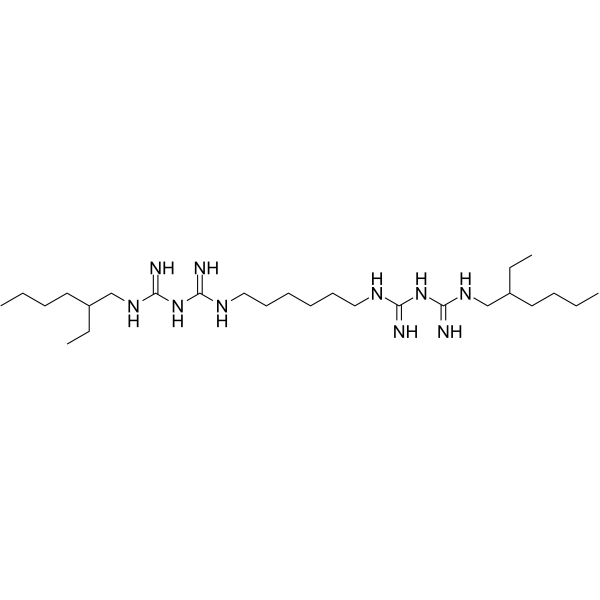22573-93-9
| Name | alexidine |
|---|---|
| Synonyms |
Imidodicarbonimidic diamide, N,N''''-1,6-hexanediylbis[N'-(2-ethylhexyl)-, hydrochloride (1:2)
1,1'-Hexamethylene-bis[5-(2-ethylhexyl)biguanide] dihydrochloride N,N''''-1,6-Hexanediylbis[N'-(2-ethylhexyl)(imidodicarbonimidic diamide)] Sterwin 904 UNII:I2A7616PY1 alexidine 2HCl 1,1'-Hexamethylene-bis(5-[2-ethylhexyl]biguanide) Bisguanidine Prestwick_42 N,N''''-1,6-Hexanediylbis[N'-(2-ethylhexyl)(imidodicarbonimidic diamide)] dihydrochloride n,n''''-hexane-1,6-diylbis[n'-(2-ethylhexyl)(imidodicarbonimidic diamide)] dihydrochloride Alexidine dihydrochloride Bisguadine Imidodicarbonimidic diamide, N,N''''-1,6-hexanediylbis[N'-(2-ethylhexyl)- N,N''''-Hexane-1,6-diylbis[N'-(2-ethylhexyl)(imidodicarbonimidic diamide)] Alexidine.2HCl alexidine QR-711 1,1'-HEXAMETHYLENE-BIS[5-(2-ETHYLHEXYL)BIGUANIDE] Compound-904 |
| Description | Alexidine, a bis-biguanide, exhibits antifungal and antibiofilm activity against a diverse range of fungal pathogens. Alexidine is an anticancer agent that targets a mitochondrial tyrosine phosphatase, PTPMT1, in mammalian cells and causes mitochondrial apoptosis[1]. |
|---|---|
| Related Catalog | |
| In Vitro | With the treatment of Alexidine (10 µM, 24 hours), biofilm community can be decimated[1]. .With the treatment of Alexidine (0-60 μg/ml, 24 hours), Alexidine can kill HUVECs and lung A549 cells[1]. Cell Viability Assay Cell Line: C. albicans, C. auris, A. fumigatus[1] Concentration: 10 µM Incubation Time: 24 hours Result: Could significantly kill 80% of mature biofilm community. Cell Viability Assay Cell Line: HUVECs, lung A549 cells[1] Concentration: 0-60 μg/ml Incubation Time: 24 hours Result: resulted in 50% killing of HUVECs and lung A549 cells ( CC50 > 7.37 μg/ml ). |
| In Vivo | With the treatment of Alexidine (Jugular vein-catheterized, 48 hours, 3 µg/ml, once) for 48 hours, Alexidine can decimate preformed biofilms growing in the jugular vein catheters of mice[1]. Animal Model: 8-week-old C57BL/6 male mice Dosage: 3 µg/ml Administration: Jugular vein-catheterized, 48 hours, 3 µg/ml, once Result: Inhibited 67% of fungal biofilm growth and viability, compared to the control untreated biofilms. |
| References |
| Density | 1.1±0.1 g/cm3 |
|---|---|
| Boiling Point | 574.5±60.0 °C at 760 mmHg |
| Melting Point | 220-224ºC |
| Molecular Formula | C26H58Cl2N10 |
| Molecular Weight | 581.712 |
| Flash Point | 301.3±32.9 °C |
| Exact Mass | 580.422302 |
| PSA | 167.58000 |
| LogP | 4.56 |
| Vapour Pressure | 0.0±1.6 mmHg at 25°C |
| Index of Refraction | 1.551 |
| Storage condition | 2-8℃ |
| Hazard Codes | Xi: Irritant; |
|---|---|
| Risk Phrases | 36/37/38 |
| Safety Phrases | 26-36 |
| HS Code | 29224995 |
